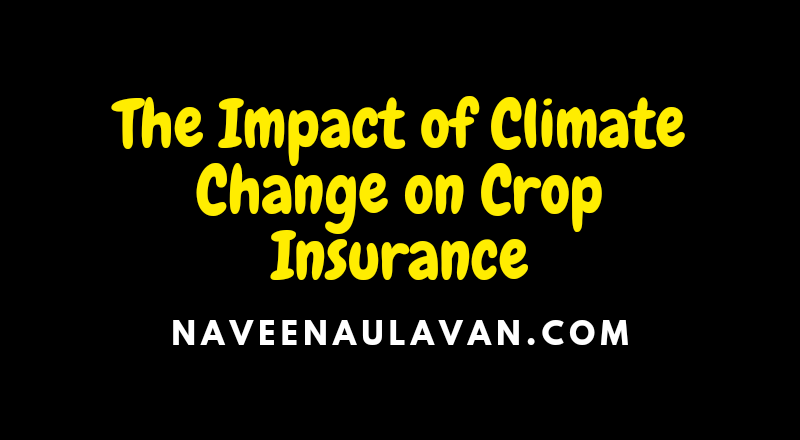Climate change is one of the most pressing challenges of our time with far-reaching implications for ecosystems economies and human well-being. One sector that is particularly vulnerable to the impacts of climate change is agriculture. As the climate continues to change farmers and agricultural producers face increasing risks and uncertainties. These risks include extreme weather events shifts in precipitation patterns rising temperatures and changes in pest and disease dynamics. To mitigate these risks crop insurance plays a crucial role in providing financial protection to farmers. However the changing climate presents unique challenges for the crop insurance industry. This article will delve into the impact of climate change on crop insurance discussing both the challenges and potential solutions.
Current Challenges Faced by Crop Insurance
Increased Frequency and Severity of Extreme Weather Events
One of the most significant impacts of climate change on agriculture is the increased occurrence and severity of extreme weather events such as droughts floods hurricanes and heatwaves. These events can cause substantial damage to crops resulting in significant financial losses for farmers. Insuring against such risks is becoming increasingly challenging for crop insurance companies due to the unpredictable nature and rising costs associated with extreme weather events.
Shifting Temperature and Precipitation Patterns
Climate change has also led to shifts in temperature and precipitation patterns altering growing seasons and crop suitability. Crops that were traditionally grown in certain regions may no longer be viable due to changes in temperature and water availability. This poses challenges for crop insurance companies as they must adapt their policies and coverage areas to reflect these changing conditions. Additionally changes in precipitation patterns can lead to water scarcity further exacerbating the vulnerability of agricultural systems.
Changing Pest and Disease Dynamics
Climate change can influence the spread and prevalence of pests and diseases impacting crop yields and increasing the need for pest management practices. Pests such as insects weeds and pathogens may expand their range or become more resistant to existing control measures due to changing climate conditions. Crop insurance companies must consider these changing dynamics when assessing the risks associated with insuring crops and determining suitable coverage options.
Potential Solutions to Address Climate Change Risks
Improved Risk Assessment and Modeling
Crop insurance companies need to refine their risk assessment models to accurately account for climate change impacts. This includes incorporating climate data historical weather patterns and predictive modeling techniques to assess the vulnerability of crops to climate-related risks. By improving risk assessment insurance companies can better predict and price policies to reflect the changing climate.
Development of Customized Insurance Products
To address the unique risks posed by climate change it is important to develop customized insurance products that align with the specific needs of farmers and agricultural systems. This could involve offering parametric insurance which pays out based on predetermined weather conditions or crop yield thresholds rather than relying solely on physical damage assessments. By providing tailored insurance products crop insurance companies can better meet the needs of farmers facing climate-related risks.
Investment in Climate Adaptation and Resilience
To mitigate the impacts of climate change on agriculture there is a growing need for investments in climate adaptation and resilience measures. Crop insurance companies can play a role in incentivizing and supporting farmers to adopt climate-smart practices such as improving irrigation systems implementing conservation agriculture techniques diversifying crop portfolios and investing in climate-resilient infrastructure. By promoting climate resilience crop insurance companies can help reduce the vulnerability of agricultural systems to climate change and minimize the need for insurance payouts.
Collaboration and Partnerships
Addressing the challenges posed by climate change requires collaboration and partnerships between various stakeholders including crop insurance companies farmers governments research institutions and international organizations. By working together these stakeholders can share knowledge resources and expertise to develop innovative solutions and policies that enhance the resilience of the agricultural sector. Crop insurance companies can play a crucial role in facilitating these collaborations and leveraging their industry expertise to inform policy discussions.
Conclusion
Climate change poses significant challenges for the crop insurance industry requiring a reevaluation of existing practices and the development of innovative solutions. Increased frequency and severity of extreme weather events shifting temperature and precipitation patterns and changing pest and disease dynamics all contribute to the vulnerability of agricultural systems. To address these risks crop insurance companies should improve risk assessment and modeling develop customized insurance products invest in climate adaptation and resilience measures and foster collaboration among stakeholders. By adapting and evolving their practices crop insurance companies can help farmers navigate the uncertain future and build a more resilient agricultural sector in the face of climate change.
